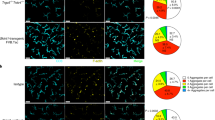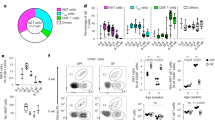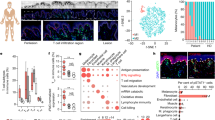Abstract
A fine balance between rates of proliferation and apoptosis in the skin provides a defensive barrier and a mechanism for tissue repair after damage. Vγ3+ dendritic epidermal T cells (DETCs) are primary modulators of skin immune responses. Here we show that DETCs both produce and respond to insulin-like growth factor 1 (IGF-1) after T cell receptor stimulation. Mice deficient in DETCs had a notable increase in epidermal apoptosis that was abrogated by the addition of DETCs or IGF-1. Furthermore, DETC-deficient mice had reduced IGF-1 receptor activation at wound sites. These findings indicate critical functions for DETC-mediated IGF-1 production in regulating skin homeostasis and repair.
This is a preview of subscription content, access via your institution
Access options
Subscribe to this journal
Receive 12 print issues and online access
$209.00 per year
only $17.42 per issue
Buy this article
- Purchase on Springer Link
- Instant access to full article PDF
Prices may be subject to local taxes which are calculated during checkout






Similar content being viewed by others
References
Edmondson, S.R., Thumiger, S.P., Werther, G.A. & Wraight, C.J. Epidermal homeostasis: the role of the growth hormone and insulin-like growth factor systems. Endocr. Rev. 24, 737–764 (2003).
Alonso, L. & Fuchs, E. Stem cells of the skin epithelium. Proc. Natl. Acad. Sci. USA 100, 11830–11835 (2003).
Lew, W., Bowcock, A.M. & Krueger, J.G. Psoriasis vulgaris: cutaneous lymphoid tissue supports T-cell activation and 'type 1' inflammatory gene expression. Trends Immunol. 25, 295–305 (2004).
Girardi, M. et al. Resident skin-specific γδ T cells provide local, nonredundant regulation of cutaneous inflammation. J. Exp. Med. 195, 855–867 (2002).
Jameson, J. et al. A role for skin γδ T cells in wound repair. Science 296, 747–749 (2002).
Girardi, M. et al. Regulation of cutaneous malignancy by γδ T cells. Science 294, 605–609 (2001).
Girardi, M. et al. The distinct contributions of murine T cell receptor (TCR) γδ+ and TCR αβ+ T cells to different stages of chemically induced skin cancer. J. Exp. Med. 198, 747–755 (2003).
Asarnow, D.M. et al. Limited diversity of γδ antigen receptor genes of Thy-1+ dendritic epidermal cells. Cell 55, 837–847 (1988).
Havran, W.L., Chien, Y.H. & Allison, J.P. Recognition of self antigens by skin-derived T cells with invariant γδ antigen receptors. Science 252, 1430–1432 (1991).
Boismenu, R. & Havran, W.L. Modulation of epithelial cell growth by intraepithelial γδ T cells. Science 266, 1253–1255 (1994).
Boismenu, R., Feng, L., Xia, Y.Y., Chang, J.C. & Havran, W.L. Chemokine expression by intraepithelial γδ T cells. Implications for the recruitment of inflammatory cells to damaged epithelia. J. Immunol. 157, 985–992 (1996).
Silha, J.V. & Murphy, L.J. Insights from insulin-like growth factor binding protein transgenic mice. Endocrinology 143, 3711–3714 (2002).
Vincent, A.M. & Feldman, E.L. Control of cell survival by IGF signaling pathways. Growth Horm. IGF Res. 12, 193–197 (2002).
Dorshkind, K. & Horseman, N.D. The roles of prolactin, growth hormone, insulin-like growth factor-I, and thyroid hormones in lymphocyte development and function: insights from genetic models of hormone and hormone receptor deficiency. Endocr. Rev. 21, 292–312 (2000).
Stentz, F.B. & Kitabchi, A.E. De novo emergence of growth factor receptors in activated human CD4+ and CD8+ T lymphocytes. Metabolism 53, 117–122 (2004).
DiGiovanni, J. et al. Constitutive expression of insulin-like growth factor-1 in epidermal basal cells of transgenic mice leads to spontaneous tumor promotion. Cancer Res. 60, 1561–1570 (2000).
Liu, J.P., Baker, J., Perkins, A.S., Robertson, E.J. & Efstratiadis, A. Mice carrying null mutations of the genes encoding insulin-like growth factor I (Igf-1) and type 1 IGF receptor (Igf1r). Cell 75, 59–72 (1993).
Rho, O. et al. Altered expression of insulin-like growth factor I and its receptor during multistage carcinogenesis in mouse skin. Mol. Carcinog. 17, 62–69 (1996).
Brown, D.L., Kane, C.D., Chernausek, S.D. & Greenhalgh, D.G. Differential expression and localization of insulin-like growth factors I and II in cutaneous wounds of diabetic and nondiabetic mice. Am. J. Pathol. 151, 715–724 (1997).
Tavakkol, A., Varani, J., Elder, J.T. & Zouboulis, C.C. Maintenance of human skin in organ culture: role for insulin-like growth factor-1 receptor and epidermal growth factor receptor. Arch. Dermatol. Res. 291, 643–651 (1999).
Kuhn, C., Hurwitz, S.A., Kumar, M.G., Cotton, J. & Spandau, D.F. Activation of the insulin-like growth factor-1 receptor promotes the survival of human keratinocytes following ultraviolet B irradiation. Int. J. Cancer 80, 431–438 (1999).
Walsh, P.T., Smith, L.M. & O'Connor, R. Insulin-like growth factor-1 activates Akt and Jun N-terminal kinases (JNKs) in promoting the survival of T lymphocytes. Immunology 107, 461–471 (2002).
Jameson, J.M., Cauvi, G., Witherden, D.A. & Havran, W.L. A keratinocyte-responsive γδ TCR is necessary for dendritic epidermal T cell activation by damaged keratinocytes and maintenance in the epidermis. J. Immunol. 172, 3573–3579 (2004).
Bigby, M. et al. Most γδ T cells develop normally in the absence of MHC class II molecules. J. Immunol. 151, 4465–4475 (1993).
Mombaerts, P. et al. RAG-1-deficient mice have no mature B and T lymphocytes. Cell 68, 869–877 (1992).
Koshizuka, S. et al. The beneficial effects of recombinant human insulin-like growth factor-I (IGF-I) on wound healing in severely wounded senescent mice. Surg. Today 27, 946–952 (1997).
Jeschke, M.G., Schubert, T. & Klein, D. Exogenous liposomal IGF-I cDNA gene transfer leads to endogenous cellular and physiological responses in an acute wound. Am. J. Physiol. Regul. Integr. Comp. Physiol. 286, R958–R966 (2004).
Barbieri, M., Bonafe, M., Franceschi, C. & Paolisso, G. Insulin/IGF-I-signaling pathway: an evolutionarily conserved mechanism of longevity from yeast to humans. Am. J. Physiol. Endocrinol. Metab. 285, E1064–E1071 (2003).
Shires, J., Theodoridis, E. & Hayday, A.C. Biological insights into TCR γδ+ and TCR αβ+ intraepithelial lymphocytes provided by serial analysis of gene expression (SAGE). Immunity 15, 419–434 (2001).
Brocardo, M.G. et al. Early effects of insulin-like growth factor-1 in activated human T lymphocytes. J. Leukoc. Biol. 70, 297–305 (2001).
Pifer, J., Stephan, R.P., Lill-Elghanian, D.A., Le, P.T. & Witte, P.L. Role of stromal cells and their products in protecting young and aged B-lineage precursors from dexamethasone-induced apoptosis. Mech. Ageing Dev. 124, 207–218 (2003).
Su, H.-Y. et al. Mouse keratinocytes express c98, a novel gene homologous to bcl-2, that is stimulated by insulin-like growth factor 1 and prevents dexamethasone-induced apoptosis. Biochimica et Biophysica Acta (BBA) - Gene Struct. Exp. 1676, 127–137 (2004).
Ghofrani, A., Holler, D., Schuhmann, K., Saldern, S. & Messmer, B.J. The influence of systemic growth hormone administration on the healing time of skin graft donor sites in a pig model. Plast. Reconstr. Surg. 104, 470–475 (1999).
Bitar, M.S. Insulin and glucocorticoid-dependent suppression of the IGF-I system in diabetic wounds. Surgery 127, 687–695 (2000).
Blakytny, R., Jude, E.B., Martin Gibson, J., Boulton, A.J. & Ferguson, M.W. Lack of insulin-like growth factor 1 (IGF1) in the basal keratinocyte layer of diabetic skin and diabetic foot ulcers. J. Pathol. 190, 589–594 (2000).
Havran, W.L. A role for epithelial γδ T cells in tissue repair. Immunol. Res. 21, 63–69 (2000).
Guo, L., Yu, Q.C. & Fuchs, E. Targeting expression of keratinocyte growth factor to keratinocytes elicits striking changes in epithelial differentiation in transgenic mice. EMBO J. 12, 973–986 (1993).
Revest, J.M., Suniara, R.K., Kerr, K., Owen, J.J. & Dickson, C. Development of the thymus requires signaling through the fibroblast growth factor receptor R2-IIIb. J. Immunol. 167, 1954–1961 (2001).
Werner, S. et al. The function of KGF in morphogenesis of epithelium and reepithelialization of wounds. Science 266, 819–822 (1994).
Nissley, S.P. & Rechler, M.M. Somatomedin/insulin-like growth factor tissue receptors. Clin. Endocrinol. Metab. 13, 43–67 (1984).
Finch, P.W., Rubin, J.S., Miki, T., Ron, D. & Aaronson, S.A. Human KGF is FGF-related with properties of a paracrine effector of epithelial cell growth. Science 245, 752–755 (1989).
De Moerlooze, L. et al. An important role for the IIIb isoform of fibroblast growth factor receptor 2 (FGFR2) in mesenchymal-epithelial signalling during mouse organogenesis. Development 127, 483–492 (2000).
Guo, L., Degenstein, L. & Fuchs, E. Keratinocyte growth factor is required for hair development but not for wound healing. Genes Dev. 10, 165–175 (1996).
Kecha, O. et al. Involvement of insulin-like growth factors in early T cell development: a study using fetal thymic organ cultures. Endocrinology 141, 1209–1217 (2000).
Acknowledgements
J. Barcas and A. Mayday provided technical assistance, and M. Carson, H.K. Komori, T. Meehan, D. Page and D. Witherden provided critical reading of the manuscript. Supported by the Leukemia and Lymphoma Society and National Institutes of Health (T32AI07244 and AI36964). This is manuscript number 16741-IMM from The Scripps Research Institute.
Author information
Authors and Affiliations
Corresponding author
Ethics declarations
Competing interests
The authors declare no competing financial interests.
Rights and permissions
About this article
Cite this article
Sharp, L., Jameson, J., Cauvi, G. et al. Dendritic epidermal T cells regulate skin homeostasis through local production of insulin-like growth factor 1. Nat Immunol 6, 73–79 (2005). https://doi.org/10.1038/ni1152
Received:
Accepted:
Published:
Issue Date:
DOI: https://doi.org/10.1038/ni1152
This article is cited by
-
γδ T cells control murine skin inflammation and subcutaneous adipose wasting during chronic Trypanosoma brucei infection
Nature Communications (2023)
-
γδ T Cells and Allergic Diseases
Clinical Reviews in Allergy & Immunology (2023)
-
The role of T cells in age-related diseases
Nature Reviews Immunology (2022)
-
Early development of the skin microbiome: therapeutic opportunities
Pediatric Research (2021)
-
Tick extracellular vesicles enable arthropod feeding and promote distinct outcomes of bacterial infection
Nature Communications (2021)



